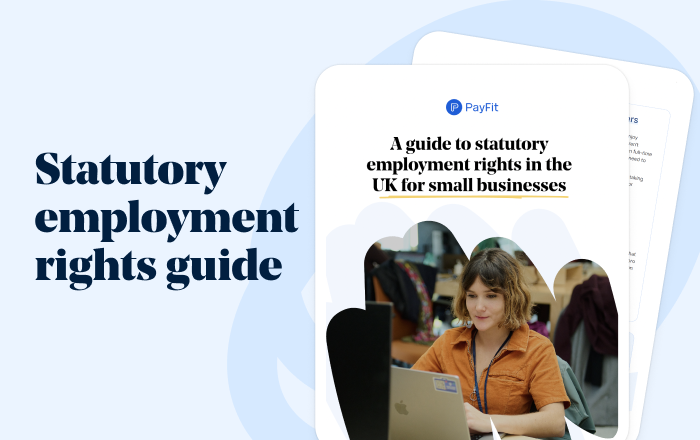✨ Health insurance, now in PayFit - learn more
💷 All the rates & thresholds you need to know for 25/26...right here
✨ The Payroll Journey: Start, Scale & Succeed Globally - learn more
✨ Health insurance, now in PayFit - learn more
💷 All the rates & thresholds you need to know for 25/26...right here
✨ The Payroll Journey: Start, Scale & Succeed Globally - learn more


Here are the critical points every manager needs to understand about redundancy:
Handling redundancies is a tough challenge for any growing organisation. The process is fraught with legal complexities and human emotions. For HR managers, finance leaders and business owners, a misstep can lead to costly employment claims, damage morale, and harm your brand image.
Understanding UK redundancy rights is essential in order to ensure compliance. This guide outlines your obligations as an employer, the rights of your staff, the right process to follow, how to calculate pay compliantly, and common pitfalls.
Before starting any redundancy process, you must be sure you have a genuine redundancy situation. Redundancy is not a tool to manage poor performance.
The legal definition is precise. Section 139 of the Employment Rights Act 1996 says a redundancy occurs when a worker’s dismissal is “wholly or mainly attributable” to one of three situations:
A business closure, i.e. when the organisation ceases to operate entirely.
A workplace closure, e.g. the closure of a branch or specific workplace location.
A reduced need for work, e.g. the requirements of the business for people to carry out work of a particular kind have ceased or diminished.
This last point is the most common, and also the most contested, since you must prove the job role itself is no longer needed. For example, if new software automates a task, the need for specific manual work may be diminished.
A fair process is your best defence against a tribunal claim. Even if the redundancy is genuine, a flawed process can make the dismissal unfair.
Redundancy consultation is a mandatory, two-way conversation, not just a one-way announcement. You must genuinely consult with staff at risk, listen to their suggestions, and try to avoid job losses.
You must inform the staff in question about:
The reasons for the proposed redundancies.
The number and types of roles at risk.
The proposed method for selecting people.
How redundancy pay will be calculated.
The timeline for the process.
In particular, the rules change according to the number of staff at risk. For 20 or more job reductions at one establishment in a period of 90 days, you will have to launch a collective consultation. This will involve a trade union or elected staff representative, and will have a minimum consultation period of 30 days for 20-99 staff, or 45 days for 100+ staff.
It’s essential to use a fair and objective selection process, and not one based on personal preferences or opinions. The selection criteria must be objectively measurable and non-discriminatory in nature.
Common criteria include:
Skills, qualifications, and experience (in relation to remaining roles).
Performance records (based on objective appraisals).
Disciplinary records.
Attendance records (discounting any leave related to disabilities, or maternity).
Remember that you must not use discriminatory criteria based on aspects such as age, gender, part-time working status, etc. Finally, it’s essential to document every decision and to gather the data used to make it.
As an employer, you are obliged to look for and offer suitable other roles within your business. A worker who then unreasonably refuses a suitable job offer may lose their right to statutory redundancy pay (SRP).
If the new role differs significantly from the old one, the individual will be entitled to a statutory four-week trial period. This lets both parties check whether the role is actually suitable, without the person losing their redundancy entitlement if it doesn’t work out.
Staff with two or more years of continuous work have an entitlement to Statutory Redundancy Pay (SRP). This is the legal minimum. This means that your company can offer a more generous contractual arrangement, but no less than the minimum.
SRP is calculated on the basis of three factors:
The individual’s age.
Their years of continuous work (up to a maximum of 20).
Their average gross weekly pay (capped at £719 for the 2025/26 tax year).
The formula is then as follows:
1.5 weeks’ pay for each full year of service over 41 years old.
1 week’s pay for each full year of service between 22 and 41.
0.5 week's pay for each full year of service under 22.
The weekly pay is capped by the government and changes annually. You can find the current rate on the gov.uk website for calculating your employee’s statutory redundancy pay. This will be a crucial number for your finance team.

UK statutory employment rights guide
Redundancy pay is only one part of the final money settlement. You must also account for holiday pay, tax, and the leaving period.
In the case of redundancy, a person is entitled to their full notice period, according to their statutory right, and their employment contract.
Statutory period: The legal minimum is one week’s notice for each year of service, up to a maximum of 12 weeks.
Contractual period: If their contract says they will get a longer notice period, you must honour that.
You can either have the person work the full period, or you can offer them Payment In Lieu of Notice (PILON), provided their contract allows for it, as per the rules on Post-Employment Notice Pay (PENP).
This is critical for payroll. The first £30,000 of a redundancy payment (statutory and contractual) is usually tax-free.
However, other payments made at the same time are taxable as normal income. This includes:
Payment in Lieu of Notice (PILON).
Any unused holiday pay.
Any normal salary or bonus due up until the termination date.
A good payroll system will differentiate these payments in order to apply tax and National Insurance deductions correctly.
Cutting corners on redundancy rights is a false economy. A dissatisfied individual can make a claim to an employment tribunal.
The two most common claims are:
Unfair dismissal: If you lacked a genuine redundancy reason or used a flawed, subjective or discriminatory process, a tribunal could rule the dismissal was unfair.
Protective award: If you fail to consult collectively (for 20+ redundancies), a tribunal can order you to pay a ‘protective award’ to all of the affected staff. This can be up to 90 days’ full pay per person.
The financial and reputational cost to your business can therefore be immense. And so it’s important to always seek expert advice.
Yes. The law provides extra protection for certain groups.
Staff on maternity, adoption or shared parental leave have special redundancy rights. If their role becomes redundant, they have the entitlement to be offered any suitable alternative vacancy first, before anyone else.
You must also ensure your selection criteria do not unfairly disadvantage part-time workers, or those on fixed-term contracts.
Managing redundancies involves a significant amount of data, calculations, and documentation. This administrative burden can pull focus from core operations.
Modern payroll and HR software such as PayFit’s can help. A good system will:
Calculate SRP: Automatically calculate the correct statutory pay using service years, age, and capped weekly earnings.
Manage timelines: Track key dates for consultation periods, notification, and termination.
Process final pay: Accurately handle the complex final payslip, separating tax-free redundancy money from taxable elements.
Store documents: Keep a secure, auditable trail, which will be vital if you face any legal claim.
Using technology like PayFit’s automated payroll software reduces the risk of human error, ensures compliance, and frees up your team to handle the more sensitive, human side of the process.

Statutory redundancy pay is the minimum amount set by law that you must pay to an eligible individual. Contractual redundancy pay is an enhanced payment offered by the company, usually detailed in the employment contract or corporate handbook. If you offer a contractual scheme, it must not be less than the statutory amount.
If your organisation is insolvent and cannot afford to pay, your staff can make a claim to the government’s Redundancy Payments Service (RPS). The RPS can pay their statutory redundancy, holiday pay, and wage arrears, subject to legal limits.
No. A person is entitled to their statutory redundancy rights and pay without signing any document. However, employers often use a ‘settlement’ if they are offering an enhanced redundancy package. In signing it, the individual agrees to waive their entitlement to claim at an employment tribunal in exchange for a better payment. Note that the individual must get independent legal advice for it to be valid.
The number of hours worked does not determine eligibility. The key factor is employment status, meaning whether the individual is formally classed as an ‘employee’. Both full-time and part-time staff will have the same redundancy rights, as long as they have been continuously employed for at least two full years. Their redundancy pay will then work out by simply calculating actual average weekly earnings.
The government updates the statutory caps on redundancy calculations, and other rates, every April. It is vital your finance team uses the correct figures. While gov.uk lists these, modern payroll software is automatically updated. PayFit’s features, for example, will ensure your payroll is always compliant with the latest UK legislation.

Learn what constructive dismissal compensation is, how it’s calculated, and the best practices UK employers should follow to avoid costly tribunal claims.

Employee handbooks give new and existing employees the chance to access important information about your company and its policies. Learn more.

Understand voluntary redundancy, its legal requirements, best practices, impacts for UK businesses, & considerations for HR, finance & business leaders.

This article provides guidance on the redundancy process, to help UK employers understand their obligations and the rights of their employees.

Contract terminations aren’t easy. This guide covers what to do as an employer when you have a redundancy, settlement agreement, death or non-starter.